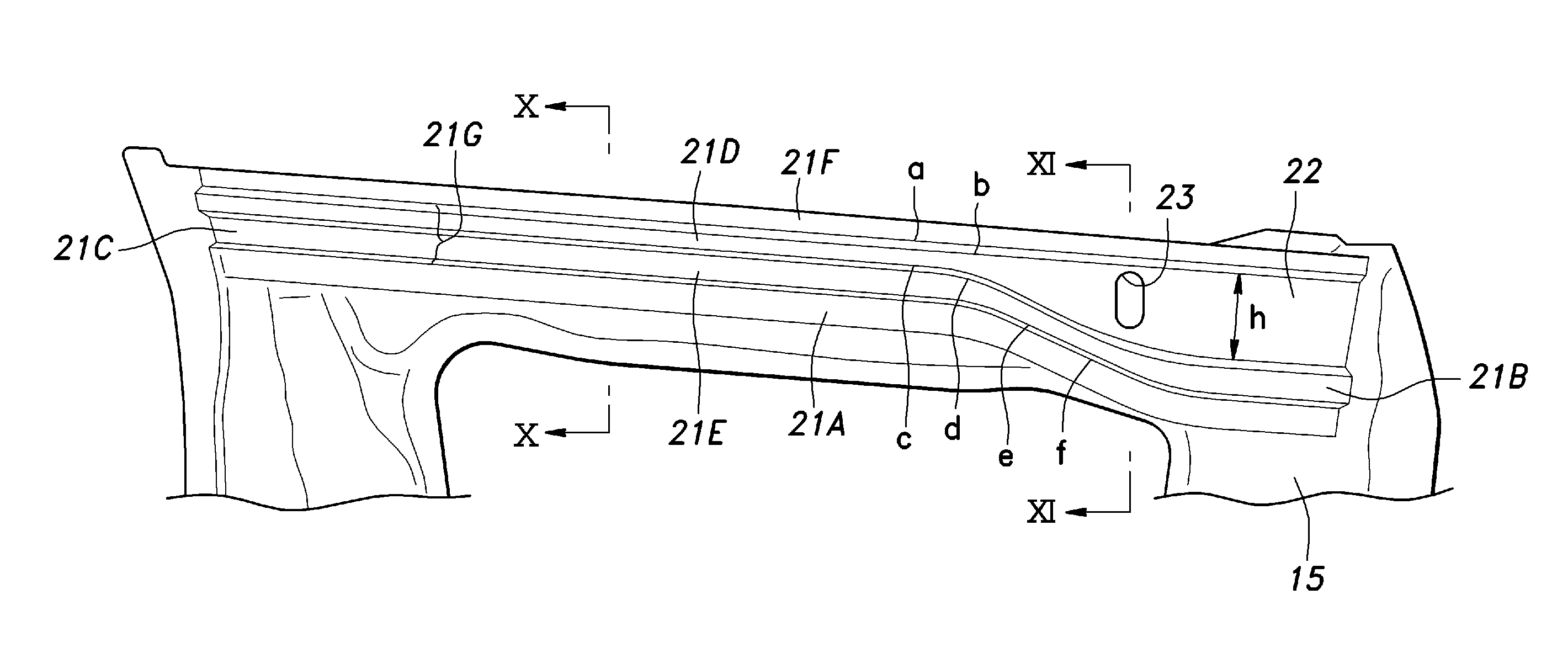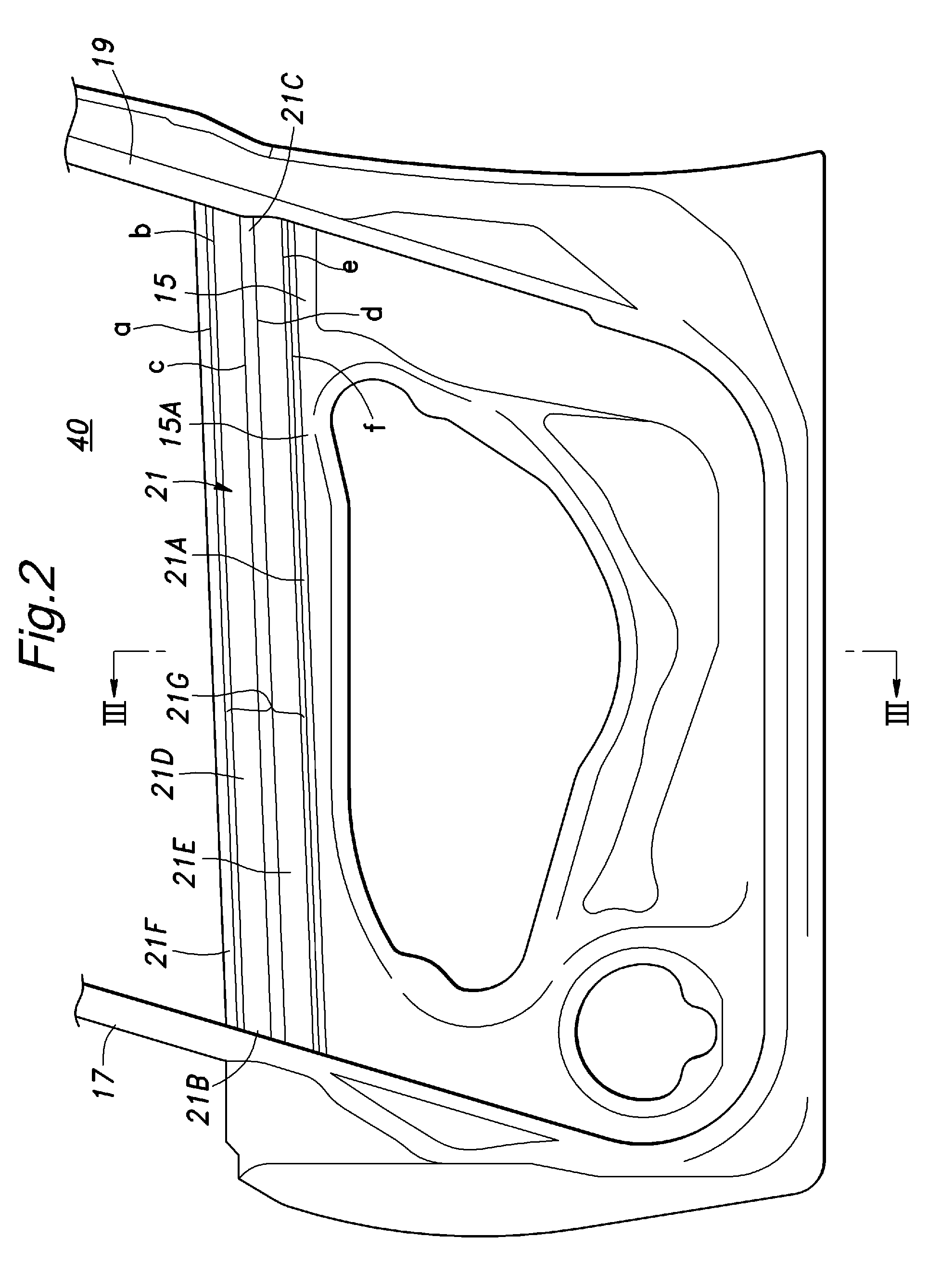Vehicle door structure and method for fabricating the same
a technology for vehicle doors and doors, applied in the field of vehicle door structures, can solve the problems of undesirable increase in material inability to absorb the energy of side impact of side impact in a favorable manner, and favorable transmission of crash load, so as to reduce the cost and weight of door beams, absorb energy, and facilitate the transmission of crash load
- Summary
- Abstract
- Description
- Claims
- Application Information
AI Technical Summary
Benefits of technology
Problems solved by technology
Method used
Image
Examples
first embodiment
[0033]the vehicle door structure of the present invention is described in the following with reference to FIGS. 1 to 6.
[0034]FIG. 1 shows a vehicle to which the vehicle door structure of the present invention is applied. In FIG. 1, numeral 1 denotes a vehicle body as a whole, numeral 3 front wheels, numeral 5 rear wheels, numeral 9 rear side doors, and 11 a tailgate.
[0035]The vehicle body structure of the present invention may be applied to any or all of the front side doors 7 and rear side doors 9. In the illustrated embodiment, the vehicle body structure of the present invention is applied to the left front door.
[0036]As shown in FIGS. 2 to 6, the front side door 7 comprises an outboard outer panel 13 and inboard inner panel 15. The space between the outer panel 13 and inner panel 15 receives a side window glass panel 31 in a vertically slidable manner.
[0037]The inner panel 15 is attached to an A-pillar 35 via a door hinge 33. The A-pillar 35 is connected to a front upper member 3...
second embodiment
[0050]FIG. 7 shows the present invention. In FIG. 7, the parts corresponding to those of the previous embodiment are denoted with like numerals without repeating the description of such parts. In this embodiment, an inner cover panel 24 having a hat-shaped cross section is attached to an inner surface of the beam member 21. More specifically, the inner cover panel 24 is provided with an upper flange that overlaps with the upper flat plate part 21F of the beam member 21 and a lower flange that overlaps with both the upper flange 15A of the inner panel 15 and lower flat plate part 21A of the beam member 21. The inner cover panel 24 may be made of steel sheet similar to the material of the remaining part of the door. In such a case, the overlapping parts are typically MIG welded, spot welded or otherwise bonded to each other. If desired, the inner cover panel 24 may also be made of other materials that provide a required mechanical strength and rigidity.
[0051]Thus, the beam member 21 a...
fourth embodiment
[0053]FIGS. 9 to 11 show the vehicle door structure according to the present invention. In FIGS. 9 to 11, the parts corresponding to those of the previous embodiments are denoted with like numerals without repeating the description of such parts.
[0054]The S-shaped cross section part 21G of the beam member 21, in particular the bottom wall of the channel member 21D is given with a locally (with respect to the fore-and-aft direction) enlarged vertical dimension or width h such as a vertically elongated part 22 formed in a front part of the beam member 21 of the illustrated embodiment. The vertically elongated part 22 is formed with an access opening 23 for assembly work.
[0055]The access opening 23 provides an access to the outer panel 13 of the front side door 7 from an inboard side when attaching a side mirror or door mirror 45 (see FIG. 1) to the outer panel 13 in a skin mount arrangement. The access opening 22 is formed in the vertically elongated part 22 without crossing any of th...
PUM
 Login to View More
Login to View More Abstract
Description
Claims
Application Information
 Login to View More
Login to View More - R&D
- Intellectual Property
- Life Sciences
- Materials
- Tech Scout
- Unparalleled Data Quality
- Higher Quality Content
- 60% Fewer Hallucinations
Browse by: Latest US Patents, China's latest patents, Technical Efficacy Thesaurus, Application Domain, Technology Topic, Popular Technical Reports.
© 2025 PatSnap. All rights reserved.Legal|Privacy policy|Modern Slavery Act Transparency Statement|Sitemap|About US| Contact US: help@patsnap.com



